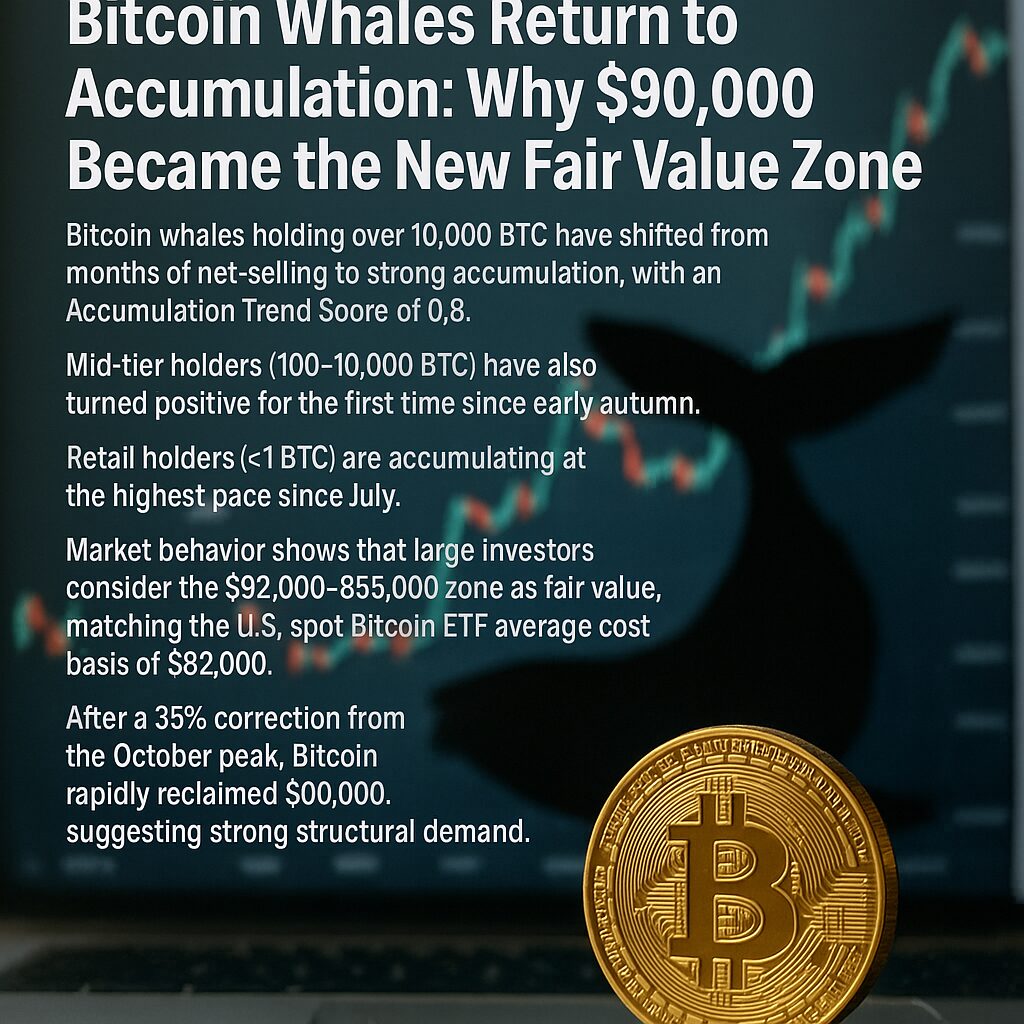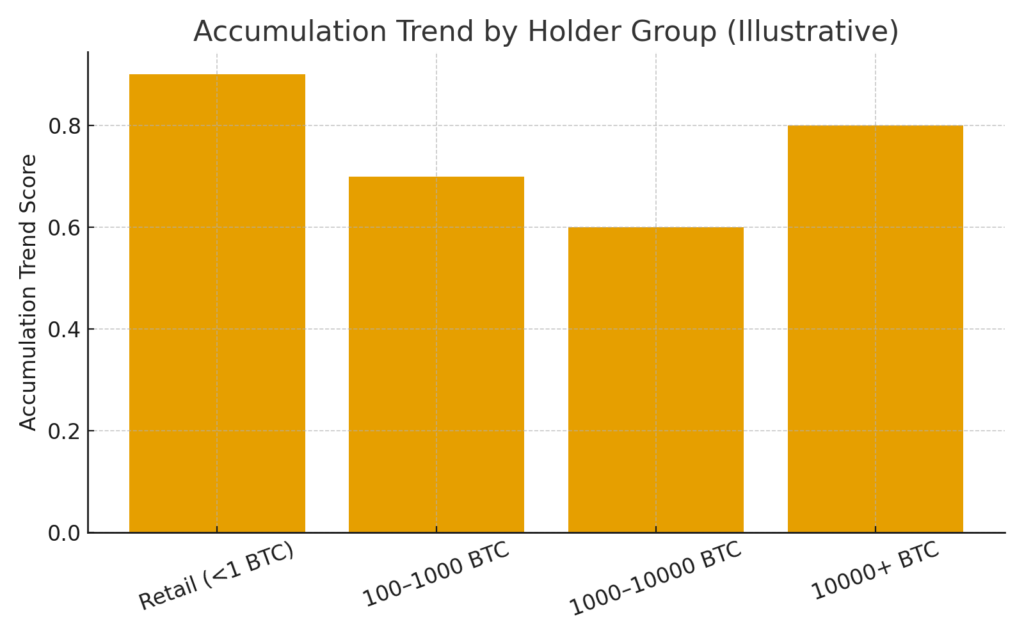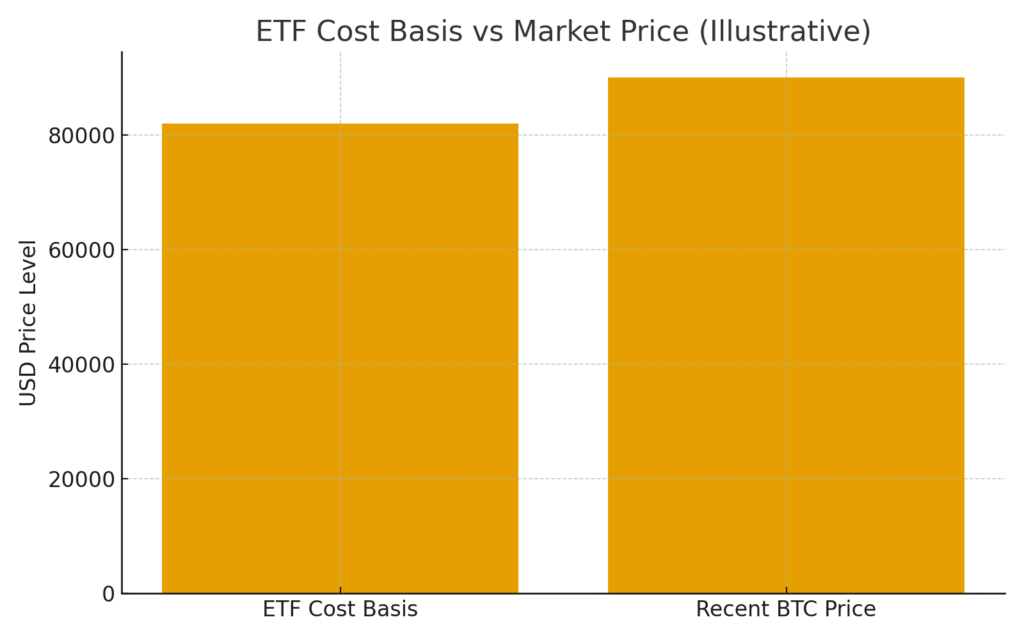
Main Points :
- Bitcoin whales holding over 10,000 BTC have shifted from months of net-selling to strong accumulation, with an Accumulation Trend Score of 0.8.
- Mid-tier holders (100–10,000 BTC) have also turned positive for the first time since early autumn.
- Retail holders (<1 BTC) are accumulating at the highest pace since July.
- Market behavior shows that large investors consider the $82,000–$85,000 zone as fair value, matching the U.S. spot Bitcoin ETF average cost basis of $82,000.
- After a 35% correction from the October peak, Bitcoin rapidly reclaimed $90,000, suggesting strong structural demand.
- Recent macro factors—ETF inflows, reduced miner selling, and expectations of 2026 rate cuts—strengthen the bullish outlook.
Introduction: A Market Reversal Led by the Largest Bitcoin Holders
After months of heavy distribution from early adopters and whale-tier Bitcoin investors, the macro psychology of the market has shifted decisively. Throughout most of 2025—particularly after Bitcoin first touched the symbolic $100,000 level—large holders took the opportunity to secure profits, reducing exposure accumulated years earlier at a fraction of today’s prices.
However, new on-chain patterns indicate a strong return of whale accumulation for the first time since August, signaling not only renewed confidence but the emergence of a structural “fair value zone” around $82,000 to $85,000. Bitcoin’s sharp recovery to $90,000 adds weight to the view that institutional buyers are anchoring their strategies around this price area.
This article synthesizes the original report with additional market intelligence, ETF flow data, macroeconomic trends, and crypto-asset investor behavior to provide a comprehensive, investor-oriented interpretation of the current Bitcoin accumulation wave.Insert Figure 1 here: BTC Price Trend (Illustrative)
File: btc_price_trend.png
Whales Resume Buying: Understanding the Shift

The End of a Multi-Month Distribution Cycle
Data from Glassnode shows that wallets holding 10,000 BTC or more have flipped from heavy selling to strong accumulation. Their Accumulation Trend Score—an index measuring net buying behavior across 15 days—now sits at 0.8, a sharp shift from near-zero levels observed during the sell-off that followed the October peak.
A score closer to 1.0 indicates aggressive net buying; closer to 0, aggressive selling.
For months, these whale addresses treated the $100,000 level not as resistance, but as an exit point—reducing long-held positions accumulated during the early cycles of Bitcoin.
Mid-Tier Investors Reinforce the Trend
Two other categories are also returning to accumulation:
- 1,000–10,000 BTC holders: Positive for the first time since September
- 100–1,000 BTC holders: Accumulating consistently since October, even during the 35% drawdown

This synchronized shift across wealth tiers suggests broad conviction about current valuation levels.
Retail Investors Are Back as Well
Holders of less than 1 BTC—typically retail buyers—are accumulating coins at the fastest rate since July. Historically, retail accumulation accelerates after whales begin buying, which matches the current pattern.Insert Figure 2 here: Accumulation Trend Scores (Illustrative)
File: accumulation_scores.png
Why Whales Are Buying Again: Key Drivers
1. The $82,000 ETF Cost Basis Has Become a Psychological Anchor

One of the most important recent developments has been the role of U.S. spot Bitcoin ETFs, which now collectively hold millions of BTC. Their blended cost basis is estimated at $82,000.
When Bitcoin corrected to this level:
- Outflows decreased significantly
- Inflows slowly returned
- Market makers noted strong buy-side liquidity reappearing
Whales mirrored this behavior by accumulating around the same area.
This implies that institutional framing of “fair value” is influencing market-wide psychology.
2. The $80,000–$85,000 Zone Matches the May Support Level
The previous high-support region from May 2025 remains technically relevant. Placing the ETF cost basis within the same zone strengthens the argument that this region now serves as:
- A structural accumulation zone
- A long-term support base
- A pricing equilibrium for whales, funds, and sophisticated investors
This type of convergence rarely happens by accident. It typically reflects a shift in how the market evaluates long-term value.
3. Bitcoin’s Recent 35% Correction Was Retested Successfully
After reaching new highs in October, Bitcoin declined by 35%, touching the low $80,000 range before stabilizing. Historically:
- Corrections of 30–40% during bullish cycles are normal
- Price recovery after re-establishing higher lows is a sign of cycle continuation
- Structural demand often appears around fair value areas, not at cycle tops
Whales buying aggressively after the correction strongly supports the view that the bull cycle remains intact.
4. Declining Miner Selling Pressure
Miner selling, one of the largest sources of natural Bitcoin supply, has decreased due to:
- Increased use of hedging instruments
- Post-halving efficiency upgrades
- Profitability from high fee markets
- Newly issued ETFs indirectly absorbing supply
According to multiple research desks, miner selling is 30–40% lower than the 2021 equivalent period.
5. Macro Tailwinds Strengthen Bitcoin’s Structural Demand
Recent macroeconomic developments also contribute to whale accumulation:
- Expectations of U.S. rate cuts in 2026
- Growing acceptance of Bitcoin as a balance-sheet asset
- Regulatory clarity in Japan, EU, and parts of Southeast Asia
- Ongoing geopolitical uncertainty elevating Bitcoin’s role as a non-sovereign asset
For large holders managing multi-year strategies, these factors justify the renewed accumulation.
Comparison With Previous Accumulation Cycles
Bitcoin has experienced several distinctive accumulation phases during its history:
| Cycle Year | Trigger | Whale Behavior | Price Outcome |
|---|---|---|---|
| 2013 | First parabolic run | Whales sold aggressively | 80% retracement |
| 2017 | ICO boom peak | Mixed whale behavior | Extended correction |
| 2020–2021 | COVID stimulus, corporate adoption | Whales accumulated | Cycle doubled in price |
| 2023–2024 | Pre-ETF speculation | Whales accumulated heavily | ETF approval → new ATH |
| Late 2025 | ETF cost basis convergence | Whales return to buying | Rapid recovery to $90,000 |
What stands out in 2025 is the precision of the accumulation zone, clearly centered around $82,000–$85,000, supported by both institutional activity and on-chain metrics.
How This Impacts Investors Searching for New Crypto Opportunities
For readers looking for:
- New crypto assets
- Alternative revenue streams
- Practical blockchain applications
…the whale accumulation narrative carries important implications.
1. Bitcoin’s Stability Benefits Emerging Tokens
When whales accumulate:
- Volatility decreases
- Liquidity improves
- Risk appetite increases
Historically, such periods have fueled altcoin rotations, favoring utility tokens with real-world use cases (payments, infrastructure, on-chain services).
2. ETF Cost Basis Becomes a Strategic Indicator
Investors increasingly monitor:
- ETF inflows/outflows
- ETF average cost basis
- Whale accumulation score
These metrics often predict market direction ahead of retail participation.
3. Infrastructure Tokens May Lead the Next Rotation
Projects focusing on:
- Web3 payments
- L1/L2 scalability
- Compliance-ready blockchain solutions
- Real-world institutional integration
…tend to benefit the most during post-correction accumulation phases.
Conclusion: A Fair Value Cycle Driven by Institutional Anchors
Bitcoin’s rapid recovery to $90,000 is not simply a rebound—it reflects a market reaching consensus about its fair value. The alignment between:
- Whale accumulation
- ETF cost basis
- Retail participation
- Reduced miner pressure
- Macro tailwinds
…indicates a new structural phase of the market.
The shift from distribution to accumulation among the largest holders is powerful. Historically, such transitions have been early indicators of multi-month bullish continuation phases.
For investors exploring new assets, income opportunities, or practical blockchain applications, the current environment offers a rare window: stability at high price levels combined with broad-based accumulation across all holder tiers.
Bitcoin appears to have entered a phase where institutional psychology—not speculative frenzy—anchors price behavior. As long as the $82,000–$85,000 region holds, the market’s upward trajectory remains fundamentally supported.

